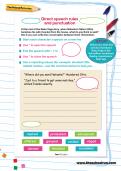Direct speech rules and punctuation
What is direct speech?
Direct speech is a way of writing or reporting exactly what someone has said, using the speaker's original words. It involves quoting the spoken words and is typically enclosed in quotation marks. In writing, direct speech helps to convey the exact language, tone, and intent of the speaker, making the dialogue more vivid and personal.
What are the rules of direct speech?
Here are the rules of direct speech:
- Quotation marks
Enclose the exact words spoken by the speaker in quotation marks. In British English, single quotation marks (‘ ’) are often used, but double quotation marks (“ ”) are also acceptable, and the preferred way to teach children in primary schools. - Punctuation Inside quotation marks
Place punctuation marks (like commas, full stops, question marks, and exclamation points) inside the quotation marks if they are part of the spoken words. - Capitalisation
Begin the direct speech with a capital letter. - New line for new speaker
Start a new line each time a different person speaks. - Reporting clause
Use a reporting clause (like he said or she asked) to attribute the spoken words to a speaker. This clause can be placed before, after, or in the middle of the direct speech. - Commas with reporting clauses
Use a comma to separate the reporting clause from the direct speech if the reporting clause comes before or in the middle of the speech. If the reporting clause follows the direct speech and the sentence continues, use a comma inside the quotation marks.
What are some examples of direct speech in a sentence?
Here are a few examples of direct speech in sentences:
Reporting clause before speech:
- Sarah said, “I’m going to the park.”
Reporting clause after speech:
- “I’m going to the park,” said Sarah.
Reporting clause in the middle of speech:
- “I’m going to the park,” Sarah said, “and I’ll be back by lunchtime.”
Direct speech as a question:
- Tom asked, “Can we play outside?”
Direct speech with an exclamation:
- “Watch out!” yelled James.
How will this direct speech worksheet help my primary school child?
This direct speech worksheet was created by an experienced teacher with the aim of helping your child understand how to use direct speech correctly. Your child will need to read the Reading comprehension: Baba Yaga first, and then answer the questions on the worksheet.
For more support with English, check out our hub page, or try a new challenge such as our Direct speech game.
DOWNLOAD THIS RESOURCE INSTANTLY
with a 14-day FREE trial!

- Thousands of English, maths & science printable and interactive resources
- Weekly learning plan for your child
- Downloadable learning packs & workbooks
*£0 TODAY*
Cancel anytime








